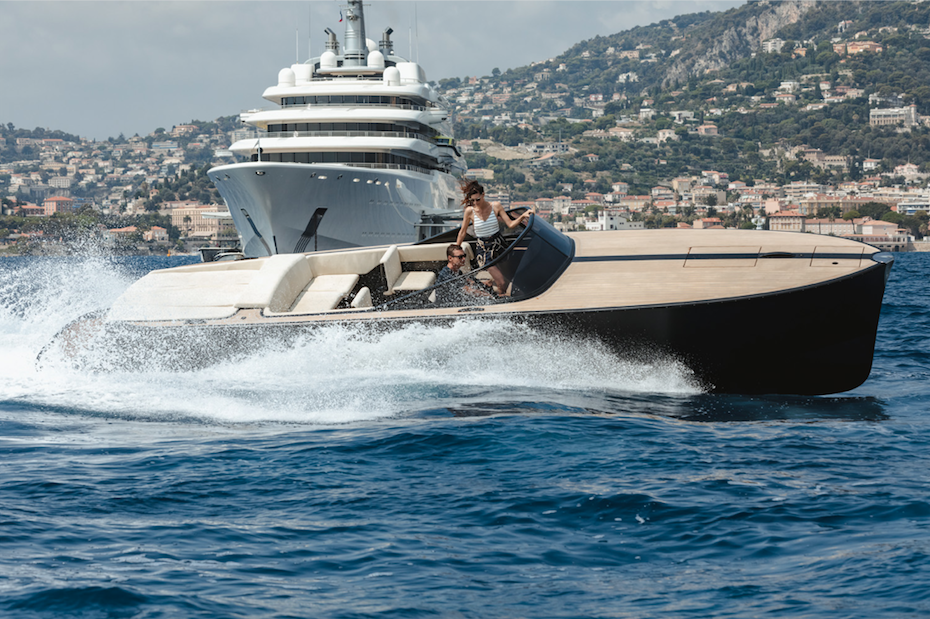The evolution of the electric superyacht tender
A market that remains both innovative and competitive…
As the yachting industry continues to demand greater sustainability from every sector, SuperyachtNews documents the ongoing evolution of electric tenders - a market that is both innovative and competitive.
Yachting Partners International (YPI) is now offering the world’s first eco-friendly day-charter on board the 10m Vita X ELECTRIX, built by Vita Yachts (shown above) – a fully electric, high performance, luxury powerboat. This is a new offering from YPI further to witnessing the increasing importance of an eco-friendly approach to tourism by its clients. “The Vita X ELECTRIX is an excellent example of this innovation in action and we are delighted to be able to offer this first fully electric day charter to our clients,” commented Abdullah Nahar, Director at YPI.
Initiatives such as this, that are a direct response to the needs and wants of current clients, further proves that it is becoming increasingly apparent within any industry involved in transportation of any kind, there is one focus: low emissions. While the superyacht industry is centred around very niche and specific types of leisure transport, great efforts are still being made to ensure the carbon footprint of these floating giants is minimised as much as possible.
Electric superyacht tenders, thanks to companies such as those interviewed in this article, are now certainly one of the ways in which these footprints can be decreased, but the conversation has also developed beyond just their fantastic environmental benefits. “There are very many benefits to electric tenders; for example, you can use the generator on board to charge the tender, and you don’t have to have petrol or diesel in the tender room, which is highly flammable. However, the experience of it – getting out there on the sea without noise or fumes is incredible,” says Konrad Bergström, president and founder of X Shore.
X Shore’s 100 per cent electric vessels have a modular railing system, so while they can be used as boats in their own right, they can be adapted to make them more similar to the functions of a tender. “We are able to design models for a specific person’s needs, as there are so many types of use. Our boat is perfect for water sports and diving, as it is really easy to get in and out of the back,” continues Bergstro¨m. “Soon we will also have accessories to dress up the tender to transform its purpose, as we can create different interiors for different needs such as a tender or a diving boat or an exploration boat – all possible by changing the interior set-up,” he adds.
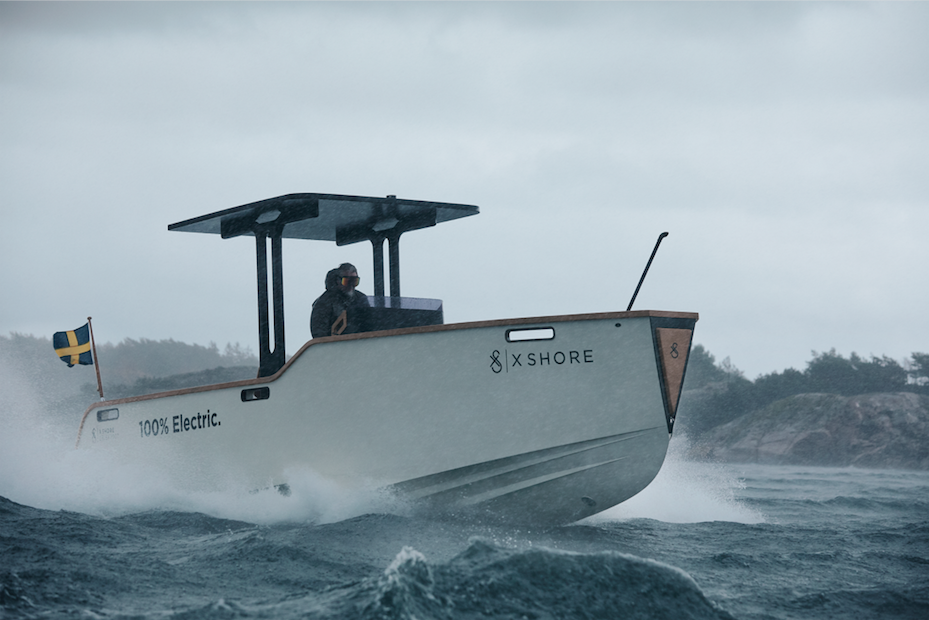
The cost-effectiveness of X Shore’s range depends on which part of the world you’re in, but, according to Bergstro¨m, “In Sweden, it’s 10 per cent of the cost to drive an electric boat compared to a diesel one.” However, Bergstro¨m also believes that money is saved in other ways through this particular type of tender, and it can essentially run at no cost at all. “If you’re on board a superyacht and you’re wasting power because the generator always has to be on, when you’re not using the power for other parts of the yacht, you can charge that power into the batteries of the e-tender,” he explains. “You can use the energy in the boat and use it as power storage. So it becomes free, as it’s energy that would have gone out anyway!”
This year, the X Shore team has been busy working on one of its latest models, the Eelex8000 (as seen in the image above). “We are currently focused on perfecting the Eelex 8000 as it comes into production, and next year we will reveal a few new products... We will reveal the special interiors so that a client can adapt the tender into an expedition boat or a diving boat. We have also just employed William Blomstrand as chief designer and this will open up a whole new dimension of the brand,” Bergstro¨m adds.
With traditional high-performance diesel superyacht tenders, the open space design of the vessel can be problematic for many reasons. “In that open space, you’re challenged with the fumes coming in from the wind. With our vessels you don’t have that issue,” emphasises Bergström. Secondly, further to the damage that is caused to the environment by these fumes, many destinations will now not allow you to anchor near them with petrol or diesel engines, meaning that there will be priority access for vessels such as the X Shore range. “There are now multiple places that have banned combustion engines, for example, all along the coast of Mallorca,” explains Bergstro¨m, highlighting this popular destination for superyachts in the Mediterranean.
This has been identified as a key point of interest for future superyacht owners, who are emerging from a generation that is very eco-conscious, and further to his keynote at The Superyacht Forum 2019, Bergstro¨m has experienced a lot of HNW individuals showing great interest. “Many have bought a boat from us, and we have more than a handful that have opted for special dimensions, but we haven’t sold any custom vessels specifically for a superyacht yet,” he clarifies.
Similarly, Naumatec (part of Nuova Jolly Marine, and focused on building luxury tenders) have experienced a great deal of curiosity both from yacht builders and brokers, as well as individual owners. “At present, this is still just curiosity and has not turned into concrete requests yet,” says Mariapia Vettori, sales manager at Naumatec.
“Besides our traditional tender range, the firstborn of the Naumatec electric tender line has been the E-TENDER 460. The tests with the 30kW engine have been really satisfactory, detecting a maximum speed of more than 40km/h in planing position, and a consumption of about 18kW/h, that guarantees a range of about 45 minutes at the maximum speed. Otherwise, in displacement, at a speed of almost 10km/h, the consumption drops to 3-4kW/h, so the range increases up to four hours,” Vettori explains.
We have decided to increase our e-tenders offering by applying the electric technology to our bigger models such as the Tenderlux 585/620 and Tenderlux 650,” adds Vettori. Having performed simulations with these models, Naumatec has discovered that with 2 x 30kW engines and 2 x 23.5kWh batteries, considering the total weight of 1,450kg (including two people on board), the estimated maximum speed is an impressive 23 knots and a range of almost 50 minutes at said maximum speed.
“We are now working to apply this hybrid technology to our existing models,” Vettori adds, emphasising the increase in demand for electric and/or hybrid vessels such as the e-tenders. “We have found that there is an increasing sensitivity towards the issue of eco-sustainability within the world of superyachts, and this is partly due to the increase in protected areas where access with traditional engines is limited or prohibited. This is leading to an increase in interest in zero-emission products, such as the tenders we build, but it will still take some time for the purchase approach to adapt to the characteristics of a boat with electric propulsion.”
As mentioned by Bergstro¨m and Vettori, it is becoming increasingly the case in Europe that many destinations have banned combustion engines, but this notion is more slowly being adopted overseas, putting pressure on the electric tender market. “More and more bodies of water are becoming electric-only. Europe’s really leading the way in terms of electric-only bodies of water, but that’s now spreading, so there’s really a variety of drivers of electric adoption,” says Annie Zamojski, product manager at Pure Watercraft – the electric outboard pioneers.
“We’ve seen the appeal of electric driven by clients wanting to be clean and green, but also multiple other things; for example, it’s quiet and more pleasant to be around when you’re in an exposed boat next to the engine,” Zamojski continues, agreeing with Bergrsto¨m’s belief that there is an elevated experience provided by e-tenders. “There is also a benefit due to the fact that there’s no regular maintenance, fewer moving parts and therefore fewer things that can break down and go wrong,” Zamojski adds.
This year, Pure Watercraft announced a strategic partnership with Highfield Boats USA – the world’s largest manufacturer of aluminium-hull rigid inflatable boats. The two companies have collaborated on the design of the new, environmentally friendly Pure Watercraft by Highfield series of all-electric-powered RIBs.
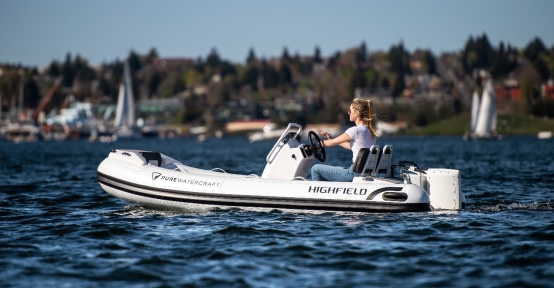
The inaugural models in the new rigid inflatable boat line are the 11’10” Pure Watercraft by Highfield Classic 360 and the 12’6” Pure Watercraft by Highfield Classic Deluxe 380. Every Pure outboard produces the equivalent of 50hp, combined with silent running, zero emissions and no maintenance.
With a two-battery-pack system, both RIBS boast a top speed of 22kn; range at top speed is 17nm. Range at a cruising speed of 14kn is 21nm, and range at a trolling speed of 2.6kn is an impressive 86nm. Built with Highfield’s durable aluminium hulls and high-quality tubes and components, the vessels are offered as complete boat-and-motor packages, they are available only directly from Pure Watercraft; pre-orders are now being taken with delivery planned for early 2021.
“This has been part of my passion for almost three years, starting from when I was involved in Torqeedo. I’ve studied electric propulsion and I’m passionate about it,” comments Tom Watson, general manager at Highfield Boats, on the partnership.
When deciding who to work with to accomplish their vision, Zamojski identified the ideals that Pure Watercraft had in mind. “High performance is what we wanted to achieve above all else. We were looking closely at what types of hulls are lightweight, but also good quality and durable, and Highfield seems to be leading the world in that field, alongside lovely designs, so this made them the perfect fit for our ideal RIB package,” she explains. “The way that the overall lightweight element manifests itself for the customers, in that the boat and the power source are both so lightweight, means that you can go further and faster. We can outperform based on power density and motor weight,” she adds.
“One of our key selling propositions is lightweight, durable vessels,” agrees Watson. “We are keenly aware of the importance of weight. Pure Watercraft have done so well on their power density offering – not only on battery power density, but also on the packaging of the motor and how they’ve been able to keep motor weight down,” he continued. “The profile of the motor that Pure Watercraft has designed will suit itself very nicely to higher-end yachts, either on the deck or into a garage. They’ve got a very low-profile motor when it’s tilted, which is great for these garages. It’s lightweight and that’s encouraging, and therefore I think they will see great success in that market.”
Although electric boats have to battle with power density, the e-tender market has had far fewer infrastructure challenges than cars, according to Zamojski, because the charger for the out-port plugs into standard power outlets that can be found on any dock. “All marina power pedestals can be used with our charger to charge the boat, so the infrastructure is already there. There are future products we can build to optimise faster charging, and further ways we can innovate, but the power is already there on the docks,” she explains.
Looking at the next five to 10 years, Watson believes that there are exciting things ahead for the electric tender market. “I don’t think we’ve defined how far we can go with [e-tenders] – perhaps if we twin them we could go very far! Pure Watercraft’s product will help drive this market segment, and we’re excited to provide them with the boats to help them be successful,” he concluded.
Developments within the e-tender market should be of interest to the superyacht industry and its greener future, considering the scalability of the technology, and especially when it comes to world firsts. After five years, Candela Speed Boat AB revealed the ‘Candela Seven’ to the market – the world’s first electric hydrofoil boat and the only electric boat able to go 50 nautical miles at 20 knots.
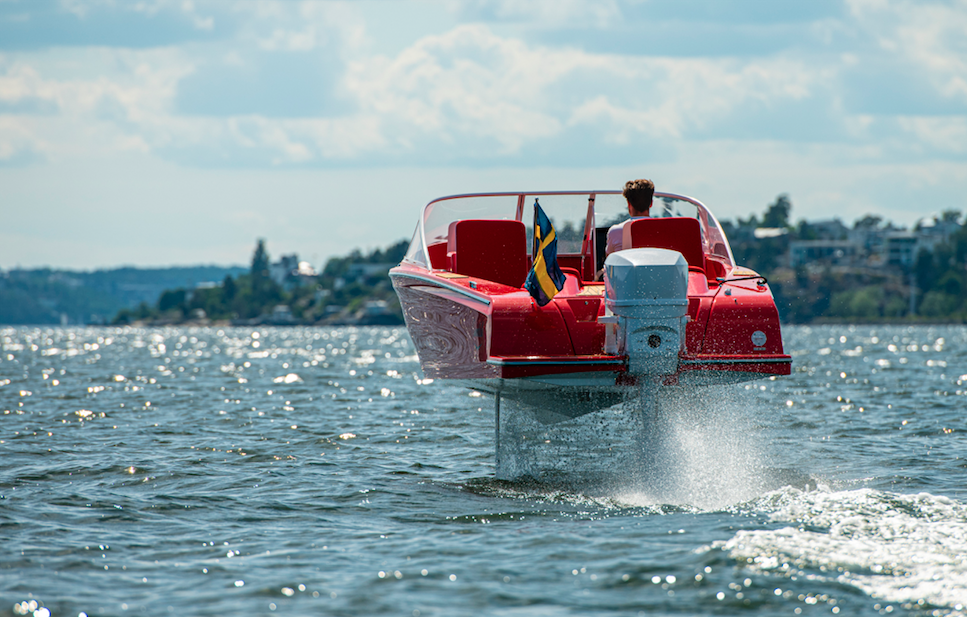
Candela Speed Boat AB was founded by engineer Gustav Hasselskog to address the fundamental issue that electric boats lack the range and speed to compete with fossil fuel boats, with planing hulls producing a lot of drag, and lithium-ion batteries being heavy and containing less energy than gasoline or diesel.
“A conventional electric boat with a planing hull will never achieve more than 20-30 nautical miles at speeds above 10 knots, even with the best batteries and a carbon fibre hull,” explains Mikael Mahlberg, PR and Communications Manager at Candela Speed Boat AB. “Since we couldn’t make batteries 400 per cent more efficient, we had to make the boat itself vastly more efficient. The solution is active, submerged hydrofoils...”
Above the waterline, Candela Seven looks like a classic, stylish runabout. Below, however, it’s a new type of craft. “Thanks to active foils that move 100 times per second, controlled by computers and sensors that detect sudden shifts in weight distribution, wave height in front of the boat etc., the ride is smooth and stable in almost all conditions,” commented Mahlberg, as the foils reduce friction by 80 per cent compared to planing boats.
From the 90kg carbon fibre hull to the 90,000 lines of code running the on-board flight controller, everything is developed in house. Hasselskog dug deep into American and Russian military research reports from the 1960s to better understand the hydro-dynamics of foiling and then built the software and sensor suites to make it fly.
“The innovative and high-tech approach to solving the problem of how electric boats can be more efficient has garnered a lot of attention from tech entrepreneurs,” continues Mahlberg. “We have delivered several boats to the British Virgin Islands and US West Coast/Silicon Valley. Alongside this, some big brands in the superyacht industry have come to us and asked for proposals to make electric, foiling yachts as well.”
The key goal for Candela is to build the first boat that is on par with fossil-fuelled boats in terms of speed and range, and superior in every other respect. “You save 95 per cent of what a gasoline-powered boat would cost to refuel. Candela Seven is the only boat able to do 40-50 nautical miles at 20 knots, which puts it on par with gas-powered competitors. Its top speed is 30 knots, and seakeeping is far better than anything in the 7.5m category. Emissions are cut by 99.5 per cent (based on charging with EU energy mix),” added Mahlberg.
This may well be Candela’s first model, for which they have just started serial production, but their mission is that foiling, electric high-speed craft shall be the norm of every boat category, up to 60m, and they are certainly one to watch within this market.
The value proposition of electric tenders is, as illustrated by these various companies, that it’s a better experience on the water and for the owner. They are easier to run, service and more enjoyable to be on board, as well as being safer and, of course, less environmentally damaging. As long as these values are communicated properly, it is likely that the market will move in the direction of e-tenders naturally.
This is an article originally published in issue 202 of The Superyacht Report. To access the full library, please click here.
Profile links
Yachting Partners International - YPI
NEW: Sign up for SuperyachtNewsweek!
Get the latest weekly news, in-depth reports, intelligence, and strategic insights, delivered directly from The Superyacht Group's editors and market analysts.
Stay at the forefront of the superyacht industry with SuperyachtNewsweek
Click here to become part of The Superyacht Group community, and join us in our mission to make this industry accessible to all, and prosperous for the long-term. We are offering access to the superyacht industry’s most comprehensive and longstanding archive of business-critical information, as well as a comprehensive, real-time superyacht fleet database, for just £10 per month, because we are One Industry with One Mission. Sign up here.
Related news
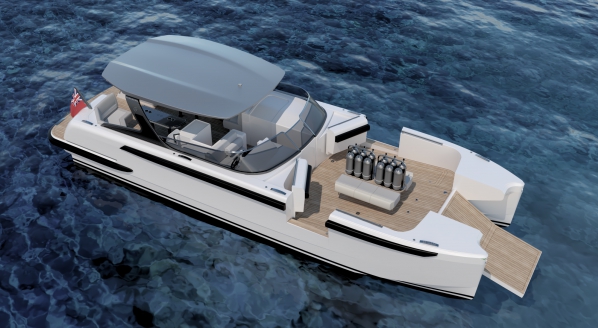
Catamaran tenders: are two hulls better than one?
Typically seen as workboats, owners are realising the benefits of these capable platforms for guest usage
Owner
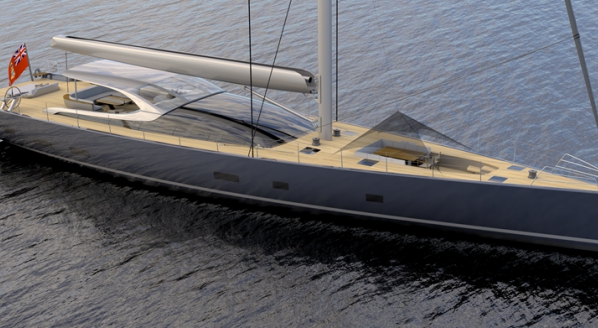
MMYD unveils new concept for charter market
The 38m sailing yacht concept has been specifically designed to fill a gap on the charter market
Design
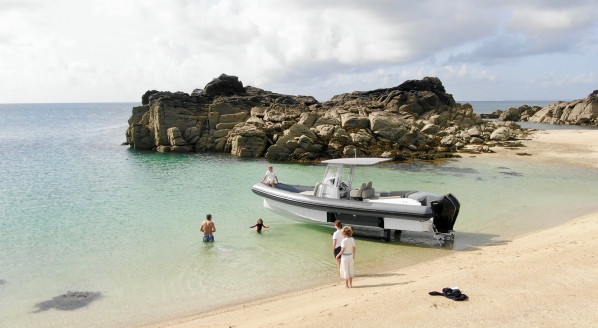
Iguana Yachts announces latest amphibious RIB model
The Iguana Knight combines the functional capability of a RIB with Iguana’s innovative mobility system
Technology

Steady growth for Shipyard Supply Co.
Luke Porter, commercial manager, provides an update as the company commences its plans for 2021/22
Business
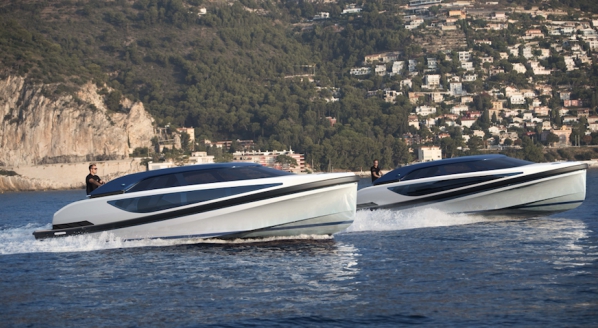
The future of the superyacht tender
Pascoe is redefining what we know to be a superyacht tender, from aesthetics to purpose
Design
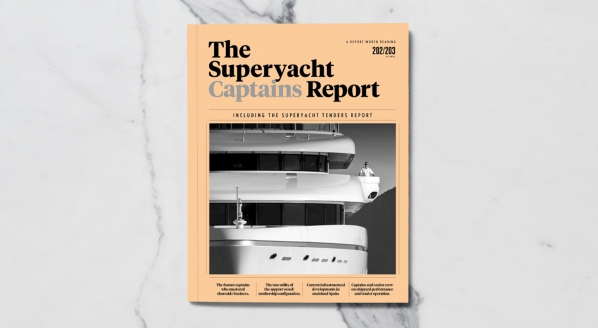
Complimentary access to The Superyacht Captains Report – out now
The latest issue, which includes The Superyacht Tenders Report and The Pinmar Magazine, is free to download
Business
Related news
MMYD unveils new concept for charter market
5 years ago
Steady growth for Shipyard Supply Co.
5 years ago
The future of the superyacht tender
5 years ago
NEW: Sign up for
SuperyachtNewsweek!
Get the latest weekly news, in-depth reports, intelligence, and strategic insights, delivered directly from The Superyacht Group's editors and market analysts.
Stay at the forefront of the superyacht industry with SuperyachtNewsweek


